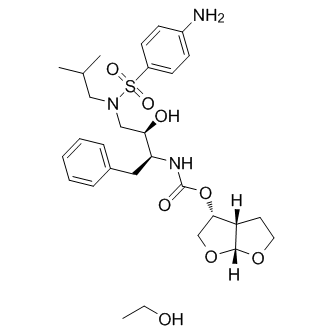| Description: |
Darunavir ethanolate (TMC114 ethanolate) is a potent HIV protease inhibitor used to treat and prevent HIV/AIDS. Darunavir has a Ki of 1 nM for wild type HIV-1 protease. |
| Target: |
Ki: 1 nM (WT HIV-1 protease)[1] |
| In Vivo: |
Darunavir is effective against wild-type and PI-resistant HIV, and has an oral bioavailability of 37%. It needs to be combined with ritonavir, which increases the bioavailability to 82%[3]. |
| In Vitro: |
Darunavir is a broad-spectrum potent inhibitor active against HIV-1 clinical isolates with minimal cytotoxicity. Darunavir forms hydrogen bonds with the conserved main-chain atoms of Asp29 and Asp30 of the protease. These interactions are proposed to be critical for the potency of this compound against HIV isolates that are resistant to multiple protease inhibitors[1]. In an in vitro study in MT-2 cells, the potency of darunavir is greater than that of saquinavir, amprenavir, nelfinavir, indinavir, lopinavir and ritonavir. Darunavir is primarily metabolized by the hepatic cytochrome P450 (CYP) enzymes, primarily CYP3A. The ‘boosting’ dose of ritonavir acts an an inhibitor of CYP3A, thereby increasing darunavir bioavailability[2]. |
| References: |
[1]. Tie Y, et al. High resolution crystal structures of HIV-1 protease with a potent non-peptide inhibitor (UIC-94017) active against multi-drug-resistant clinical strains. J Mol Biol. 2004 Apr 23;338(2):341-52.
[2]. McKeage K, et al. Darunavir: a review of its use in the management of HIV infection in adults. Drugs. 2009;69(4):477-503.
[3]. Bhalekar MR, et al. In-vivo bioavailability and lymphatic uptake evaluation of lipid nanoparticulates of darunavir. Drug Deliv. 2016 Sep;23(7):2581-2586. |






















